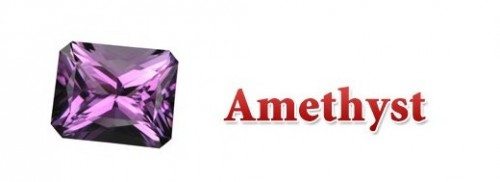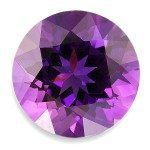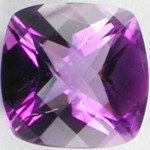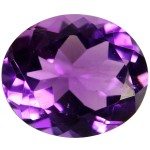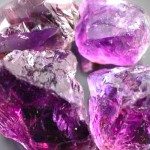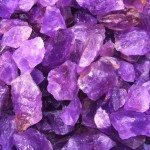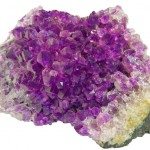Contents
Gemstone Information
Amethyst is the purple variety of the Quartz mineral family, is considered a semi precious stone and a royal stone, in fact it is very popular since ancient times, when royal family set into crowns and scepter, also Egyptians and Romans love this purple variety of the Quartz that was considered a precious stone like Ruby and Emerald. Amethyst present a color hue from violet to purple, caused by iron in the transparent colorless Quartz crystal and natural irradiation.
It is considered the purple sister of the Citrine, the yellow variety of Quartz, because heating Amethyst with high temperatures dissolve iron impurities and change the purple Amethyst color into a vivid golden yellow color typical of Citrine gemstones.
It is a popular stone and can be mined in huge quantity, often Amethyst specimens are transparent and comes with good eye clean clarity. It’s not difficult to find big Amethyst completely eye clean over 30 carats weight.
Amethyst color can vary from a pale pastel violet color to a deep and very saturated purple color.
Click here to find natural Amethyst gemstones for sale
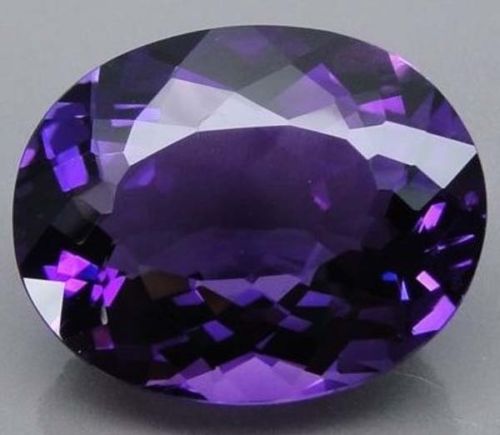
Healing Properties
The Greek name Amethyst means “not drunken” and usually it be used like a talisman to protect again intoxication, especially versus alcoholic drinks, legend says that Amethyst is good antidote to drunkness.
Amethyst is the February birthstone, and the stone for zodiac sign of fishes, assigned to the Neptune planet it can help for headaches,alcoholism and pancreatic disorders.
Treatment
Amethyst is usually treated by heat to change the purple color into the golden yellow color typical of Citrine, sometimes the heating process can transform the Amethyst color into a pale green. The green Quartz variety is called Prasiolite.
Origin and gemstone source
This variety from the Quartz mineral family is very abundant and it is not rare, it can be mined from a lot of sources, but in some case different mining sources can produce gems with unique color, like stones from Uruguay recognizable by its deep and strong saturated purple color with some tint of blue, or Amethyst from Russia and Africa.
The biggest source for this variety from the Quartz mineral family are: Brazil and South America (Bolivia, Uruguay, Mexico), Africa (Namibia, Zambia, Madagascar), Russia, United States, Canada, India, Myanmar, Sri Lanka.
Optical Effect
In some case Amethyst inclusions can show, when the crystal is cut into cabochon, the chatoyancy effect. They are called Cat’s eye Amethyst.
Photos and images
Click here to find natural gemstones for sale
Uses
The purple variety like many other Quartz variety is really abundant and can be mined in large size with transparent eye clean clarity, that can produce huge faceted stones cut in the most popular shape like: oval, cushion, pear, round, square, emerald/octagonal, trilliant, marquise, baguette and so on. Some designers also use this purple variety of Quartz to cut it into fancy shapes or carve it into sculptures.
Included stones are also cut into cabochon, or beads, rondelles and similar. Poor quality gemstones are often transformed into polished stones, wands and similar for crystal therapy.
Care and Cleaning
This stone is a relatively hard with an hardness equal to 7 on the Mohs scale of the mineral hardness, but is a good thing understand few concept that can preserve your gemstone. It is defined like a durable stone and can be used without problems in jewelry in fact it was one of the most used gemstone in ancient time, set in crowns, scepters, talismans, swords, helms.
It doesn’t need particular care, but you must avoid to expose it to high temperatures (in don’t want to transform your Amethyst into a Citrine), like the direct flame from a jeweler torch, avoid chemical products and acids when you wear it.
Clean your gemstone like any other stone, use some soapy water and a clean cloth would be enough to assure the original luster of your gemstone. Amethyst can also be scratched by harder gemstones like topaz, sapphire, aquamarine so store Amethyst separately from them.
Scam and Fraud
This stone is very abundant and is not expensive with cost relative affordable, but sometimes can happen that unscrupulous seller try to sell synthetic hydrothermal Quartz for natural gemstone.
Also other imitations with similar appearance to Amethyst are used to scam people, like purple colored glass gemstone, or plastic gems can be sold for natural Amethyst.
This gemstone can also be confused with natural gemstones with similar color like: Fluorite, purple Sapphire, purple Spinel, Iolite, Scapolite.
Click here to buy gemstones for sale
Typical Internal Inclusions
When observed under the microscope can display some interesting inclusions that can reveal more information about it. Amethyst typical internal inclusions are: “fingerprints”, 2 and 3 phase inclusions,negative crystals color zoning, twin planes.
Gemological Info
- Mineral family: Quartz
- Crystal: Hexagonal (trigonal)
- Density: 2.66
- Hardness: 7
- Refractive index: 1.544 – 1.553
- Optic Character: DR Uniaxial positive
- Color: Purple (variable intensity and saturation from pastel to deep purple)
- Cause of color: presence of Iron and natural irradiation
- Luster: Vitreous
- Clarity: Type 1 (often eye clean)
- Fluorescent: Inert
- Fracture: Conchoidal
- Cleavage: None
- Durability: Good
Click here to find natural gemstones for sale

